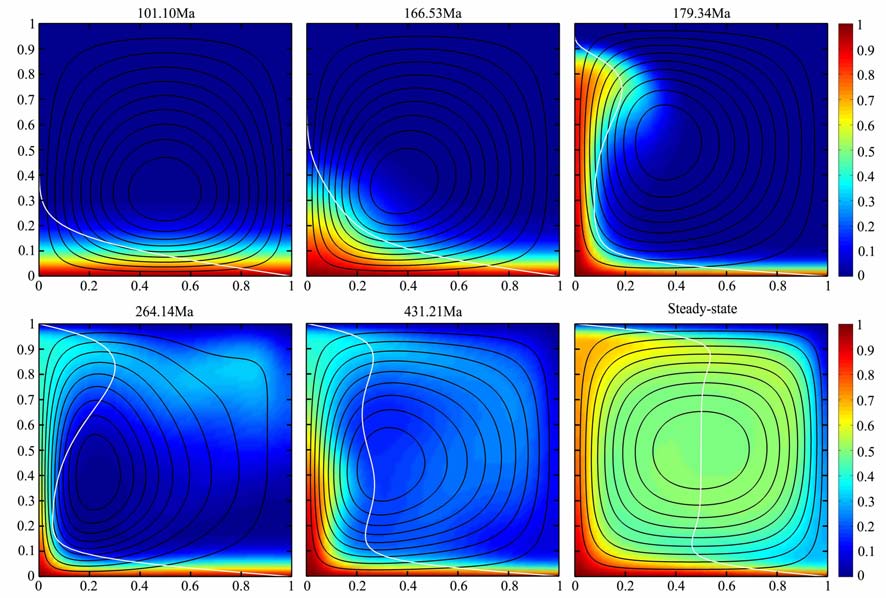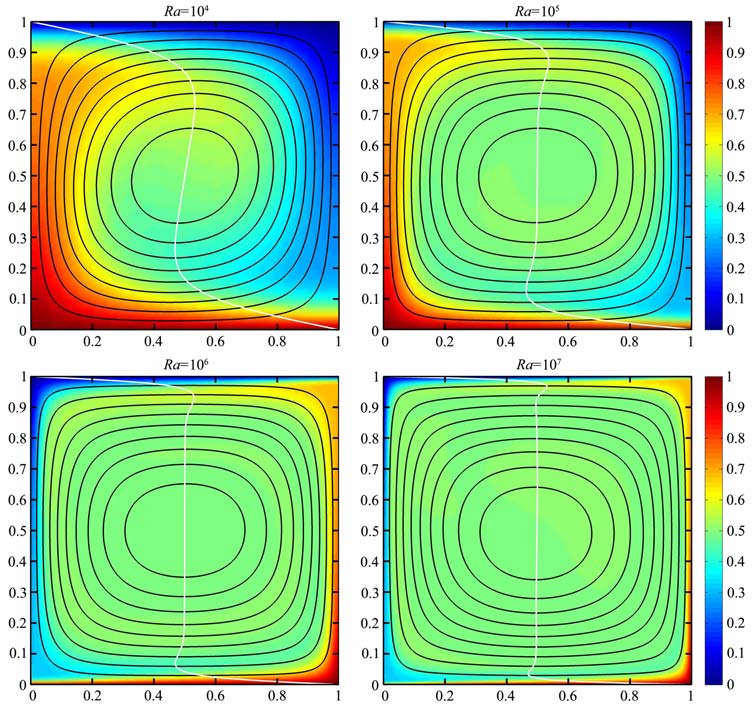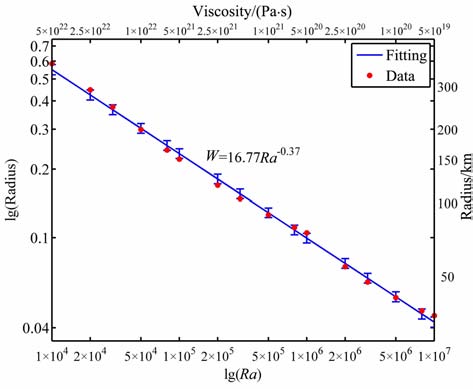2. 中国科学院研究生院, 北京 100049
2. Graduate University, Chinese Academy of Sciences, Beijing 100049, China
1963年,Wilson 为解释夏威夷火山岛链的成因,提出了“热点"的概念[1].Morgan将其作为板块移动机制的一种学说:认为这些热点是地幔柱构造在地表的表现形式[2, 3],经过数十年的科学探索,地幔柱作为一种重要的地球动力学机制得到了地质、地球物理以及地球化学等众多证据支持.随着计算机技术的迅速发展,地幔柱动力学的模拟也逐渐成为研究地幔柱的一种重要方法.
广泛出露于扬子板块西缘川、滇、黔三省的晚二叠世峨眉山玄武岩(263~253 Ma[4])是我国唯一被国际学术界认可的大火成岩省[5, 6],通常认为大火成岩省的形成大多与地幔柱活动有关,因为地幔柱模型提供了解释在相对短的时间内(几百万年)产生巨量岩浆的可行的动力学机制[7].Chung等[4]根据短时间内大量玄武岩的喷发及苦橄岩等的研究,首先提出了峨眉山玄武岩为地幔柱与岩石圈作用的产物.徐义刚等[7]根据苦橄岩中橄榄石斑晶等的研究,证明了峨眉山玄武岩与地幔柱活动有关.根据茅口灰岩的剥蚀程度来划分内带(Innerzone, 半径约为150km)、中带(Intermediatezone, 半径约为400km)以及外带(Outerzone)[8].
早在1935年Haskell[9]利用冰盖融化后回跳,计算出上地幔的黏性系数为1020 Pa·s, 开创了“可流动地幔"的概念,为地幔对流可能存在提供了物理学依据.1975 年,Cathles[10]从冰期后回跳、冰盖融化引起的海平面的升高等因素出发,得出软流圈、地幔的黏性系数为1021 Pa·s.后来许多学者分别从冰期后回跳、大地水准面、板块运动速度等出发[11-16]获得地幔的黏性系数.虽然方法大不相同,但是他们的结果基本上是一致的:地幔黏性系数的量级都在1021 Pa·s.此外,实验和理论研究表明,地幔的黏性系数依赖于温度和压力[17, 18].
地幔对流是一种自然对流,又是地球内部向地球表面输送物质和能量最有效途径,吸引广大国内外学者的关注[19-41].
本文先在直角坐标系中,定性地描述热对流发展的过程,得到不同瑞利数(从104 逐渐增大到107)对热对流发展的影响,并定量地给出稳态下瑞利数对“管道"宽度的影响;再从柱坐标出发,拟合出地幔柱半径随瑞利数变化的关系式.最后根据上地幔的合理黏性、热膨胀系数物性参数,计算出源自上地幔的地幔柱的半径的范围为:90~210km.根据峨眉山内带半径,估算出峨眉山地区地幔黏性系数为3.8×1021Pa·s, 地幔柱平均流动速度为2.5cm/a.
2 控制方程、初始条件以及边界条件热对流必须遵从质量守恒、动量守恒、能量守恒定律[42].将地幔看成不可压缩的流体,忽略内生热(放射性元素衰变放热),并认为地幔的普朗特数Pr近似为无穷大,在Boussinesq 近似下,热对流的无量纲方程组可描述为[8, 43-46]

|
(1) |
其中u、P和T分别为速度矢量、压力和温度;ey是y方向的单位矢量;υ 为无量纲化后的运动学黏性系数,它与动力学黏性系数μ 的关系为υ =μ/ρ0,其中ρ0 是地幔的参考密度.
Ra是按下式定义的瑞利数(Rayleighnumber):

|
式中α、μ0、υ0、κ 分别为地幔的热膨胀系数、参考动力学黏性系数、参考运动学黏性系数以及热扩散系数;g为重力加速度;ΔT是模型上下边界的温度差.瑞利数仅出现在动量方程中的体力项,故瑞利数是表征自然对流中热浮力与扩散热量/质量传递之比的一个物理量.
本文所采用的基本无量纲因子见表 1.
|
|
表 1 无量纲因子 Table 1 Dimensionless factor |
表 2是模型的一些几何参数和物性参数.
|
|
表 2 模型的物理和几何参数 Table 2 Physical and geometrical parameters of model |
初始温度为零,并加了万分之一的简谐扰动.边界条件的设置如下:四周为自由滑移速度边界条件;上表面为低温,下表面为高温,两侧为零热流边界条件.
根据热对流理论分析表明:当瑞利数很高时,能量方程中的非线性项将起主导作用,线性理论分析已经不再适用[47].通常认为Ra<108 为层流;而108<Ra<1010为层流与湍流的过渡阶段.本文所取的瑞利数范围是104 到107.
3 计算结果将1×1归一化的方形区域剖分成64×64个矩形单元(当Ra≥1×106 时开始增加网格数,直至128×128,并在边界附近进行局部加密).本文利用Citcom 代码[48-51]进行模拟(Uzawa算法求得速度和压力;SUPG 算法求得温度),时间步长满足:CFL(CourantFriedrichsLewy)条件.成图均由Matlab完成.
3.1 Ra=105 算例初始时刻,内部的温度很低,底部温度很高,底部附近的温度梯度很大,温度将升高,密度减小,会产生一个向上的浮力,底部附近低密度的流体有上升的趋势.但是物质要发生流动,还必须克服阻碍介质流动的黏性阻力.显然当浮力小于流体层中的黏性阻力时,即便存在向上的浮力,流体也不会运动.只有当浮力大于阻碍介质运动的黏性阻力时,流体才会发生流动.这种在没有外力的作用下,仅靠流体内部温度差,使流体流动的现象,就是自然对流[52].
图 1给出不同时刻温度及流线的分布图.图中的物理量都是无量纲化后的量(以下如无特别说明,都是无量纲量).其中颜色代表温度(红色为高温,蓝色为低温);黑线为流函数等值线(流线);白线代表水平平均温度随深度变化曲线(横坐标为水平平均温度,纵坐标为深度).

|
图 1 Ra=105 时不同时刻温度以及流线分布图 Fig. 1 Temperature and streamline distribution for Ra=105 |
101.10 Ma时,底部附近的流体温度已经升高,但还未形成对流(浮力仍比黏性力小),该阶段以热传导为主[43-45].166.53 Ma开始形成对流,左侧热的流体开始上升,水平平均温度开始偏离热传导的余误差函数的范畴.在热物质上升的过程中会使其周围的流体的温度升高.179.34Ma上升的热物质到达地表,并在上表面低温、自由滑移边界条件的限制下,向水平方向流动,也使得上表面附近的温度升高.另外在上升“管道"内温度急剧变化,形成热边界层.从264.14Ma的水平平均温度曲线可以看出,上表面附近的温度有了明显的提高,产生较大的温度梯度,有下沉的趋势,另一方面上升“管道"附近受到中心部分低温流体的作用,使得“管道"变窄,但底部一直对系统进行加热,会继续产生向上的浮力.431.21Ma又产生新一轮的较强的对流,先前“管道"重新打开.很明显,热对流与水平平均温度分布是相关的,随着底部热物质的上升,带来了大量的热使得系统温度升高,水平平均温度分布图向右移动.
稳定状态,在顶部存在一个冷的热边界层、右侧下降的“管道"也可视为垂直方向上冷的热边界层.同样在底部和左侧亦形成热的热边界层,边界层及流线极其对称,构成对流环.
稳态时,水平平均温度曲线具有如下特点:
(1) 温度变化主要集中在顶部和底部:在顶部存在着一个冷的热边界层;在底部存在一个热的热边界层,并且两个边界层的对称性很好.
(2) 中间区域的温度变化比较平缓.
(3) 核部(等温核)的温度等于上下边界温度的平均值.
这些特点也是系统是否达到稳定状态的具体依据.水平平均温度是判别系统是否达到稳态的一个较为理想的物理量.
3.2 不同瑞利数,稳态的温度分布情况图 2是瑞利数分别为104、105、106、107稳态时温度、流线以及水平平均温度分布.不同瑞利数,稳态时都形成一个对称的对流环、核部温度不变;但瑞利数越大,核部区域越大、“管道"的宽度越小.

|
图 2 不同瑞利数,稳态时温度以及流线分布图 Fig. 2 Steady-state temperature and streamline distribution for various Ra |
稳态时,在y=0.5(330km深度)剖面上,与边界温差达到边界与中心温差的90%(约687K)的位置,为“管道"的宽度.左右“管道"的宽度分别定义为WL =xL 和WR =1-xR,其中xL 和xR 满足

|
(2) |
表 3给出“管道"宽度随瑞利数变化的数据.同一个瑞利数,左右“管道"的宽度基本相同,体现了良好的对称性.瑞利数较大时(Ra≥1×106),通过增加网格数、加密边界附近的网格来提高分辨率.
|
|
表 3 不同瑞利数的“管道"宽度 Table 3 Width of channel for various Ra |

|
图 3 “管道"宽度与瑞利数的关系 Fig. 3 Width of channel as a function of the Rayleigh number |

|
(3) |
对于地幔柱,选用柱坐标模型比直角坐标模型要更为合适.图 4给出柱坐标下,Ra=105 的地幔柱演化过程:79.50 Ma地幔柱头开始形成;106.01Ma地幔柱头到达上表面,历时26.5Ma左右,这一阶段平均速度约为2.49cm/a.

|
图 4 柱坐标模型中,Ra=105 时不同时刻温度以及流线分布图 Fig. 4 Temperature and streamline distribution for Ra =105 in cylindrical coordinates |
图4c给出地表热流随时间变化图.由于地幔柱从深部带来热的物质,当地幔柱柱头到达地表附近时,使得地表附近的温度升高、地表热流增加.故可根据地表热流的信息来判断地幔柱是否到达上表面.可以认为106.01 Ma, 地幔柱已经到达上表面.地表热流仅仅反映地表附近温度场的分布,而地表地形则不然.图 4d则是给出地表地形随时间变化图.即便柱头还没有到达地表(如94.32 Ma),中心附近仍有0.8km左右的地形.当地幔柱到达地表时,地幔柱中心的地形约5.5km, 平均地形为1.03km.另外,地幔柱影响地表地形的范围约为300km.
3.5 瑞利数对地幔柱半径的影响类似直角坐标中瑞利数对“管道"宽度的影响,计算出不同瑞利数相应的地幔柱半径.
值得说明的一点是:地幔柱模型并没有计算至稳态,而是基于地幔柱柱头到达地表(地表热流开始发生变化)时,在y=0.5(330km深度)剖面上热边界层的厚度,见图 5,其中线是温度;黑色十字标志是热边界层的厚度,即地幔柱半径.同样地,瑞利数越大,温度梯度越大,热边界层越薄,地幔柱半径也越小.另外,瑞利数越大,上升到地表的花费时间(图中的时间起点是初始状态)也少.

|
图 5 不同瑞利数,当地幔柱到达地表时,y=0.5剖面温度分布图 Fig. 5 Temperature distribution of profile of y=0.5 for various Ra when mantle plume reaches the surface |
针对不同瑞利数的地幔柱半径数据进行拟合(图 6),得:

|
图 6 地幔柱半径与瑞利数的关系 Fig. 6 Radius of mantle plume as a function of the Rayleigh number |

|
(4) |
对于瑞利数为105的地幔,地幔柱半径约为156km, 按上面提到的平均每年可上升2.49cm, 一年约有1.9km3 的通量.
地幔黏性系数的量级为1021 Pa·s, 由上面的拟合公式,可以计算出源自上地幔的地幔柱半径的范围为:90~210km.特别地Turcotte等[43]给定的地幔黏性系数为:1.1×1021 Pa·s,相应的地幔柱的半径约为100km.
3.6 峨眉山地幔柱根据峨眉山茅口灰岩的剥蚀程度,内带半径约为150km[7, 8, 53].由式(4)可得瑞利数为1.1×105,相应的峨眉山地区地幔的动力学黏性系数为3.8×1021 Pa·s.图 4给出Ra=105 的计算结果对于峨眉山应当是适用的.
峨眉山火山岩区岩层总体特征---西厚东薄:如云南宾川上仓(西区),玄武岩层厚达5000m,而贵州境内(东区),玄武岩层的厚度仅为几十至几百米[7, 54],并且东区岩性较为单一,主要是高钛玄武岩石;而西区岩石较为复杂[54].图4d显示地幔柱中心的地形在5km左右,而地幔柱远端则出现-500m左右的地形,本文的模拟过程中并没有考虑沉积剥蚀的过程.
峨眉山玄武岩石的面积为2.5×105 km2,体积为0.3×106 ~0.6×106 km3 [7, 8, 53, 54].平均厚度为1.2~2.4km.图 4d计算的平均地形为1.03km.
上面我们给出地幔柱在上升过程中,平均速度为2.49cm/a,该结果与李建康等[55]基于全地幔对流给出峨眉山地幔柱2.8cm/a的抬升速度是一致的.对于150km半径的地幔柱,则每年约有1.8km3 的通量,只要0.3Ma的时间就可以吞吐峨眉山玄武岩的体积.当然,地幔柱通量并不是全部都往地表输送,相当一部分进入地幔中进行循环.
4 结论与讨论(1) 热对流的物理本质是由于热膨胀引起的密度变化从而导致了介质的流动.临界瑞利数描述的是流体由静止状态到流动状态的条件.
(2) 稳态的温度场分布:四周都有一个热边界层,中心区域温度变化平缓.
(3) 瑞利数越大,越容易对流,并且形成的“管道"或地幔柱也越窄,相应的顶部和底部的热边界层也越薄.
(4) 在地幔黏性合理的范围内,地幔柱半径为90~210km, 主要与地幔黏性相关.
(5) 峨眉山大火成岩省内带的半径约150km, 估算地幔的黏性系数为3.8×1021 Pa·s.地幔柱平均每年上升2.49cm, 每年的通量为1.8km3.这为在相对短的地质时间内(几百万年)产生巨量岩浆提供了可能.
致谢中国科技大学黄金水教授在Citcom 代码解读等诸多方面提供了无私的帮助.美国加州理工学院冷伟博士提供了柱坐标系下的Citcom 代码.另外两位审稿人提出的修改意见和建议对本文的完善和提高有很大的帮助,在此一并表示感谢!
| [1] | Wilson J T. A possible origin of the Hawaiian Islands. Canadian J| of Physics , 1963, 41: 863-870. |
| [2] | Morgan W J. Convection plumes in the lower mantle. Nature , 1971, 230: 42-43. DOI:10.1038/230042a0 |
| [3] | Morgan W J. Deep mantle convection plumes and plate motions. American Association of Petroleum Geologists Bulletin , 1972, 56: 203-213. |
| [4] | Chung S L, Jahn B M. Plume-lithosphere interaction in generation of the Emeishan flood basalts at the Permian-Triassic boundary. Geology , 1995, 23: 889-892. DOI:10.1130/0091-7613(1995)023<0889:PLIIGO>2.3.CO;2 |
| [5] | Mathoney J J, Coffin M F. Large igneous provinces: Continental, oceanic and planetary flood volcanism. American Geophysical Union Geophysical Monograph 100 , 1997. |
| [6] | Courtillot V, Jaupart C, Manighetti I, et al. On causal links between flood basalts and continental breakup. Earth and Planetary Science Letters , 1999, 166: 177-195. DOI:10.1016/S0012-821X(98)00282-9 |
| [7] | 徐义刚, 钟孙霖. 峨眉山大火成岩省:地幔柱活动的证据及其熔融条件. 地球化学 , 2001, 30(1): 1–9. Xu Y G, Chung S L. The Emeishan large igneous province: evidence for mantle plume activity and melting conditions. Geochemical (in Chinese) (in Chinese) , 2001, 30(1): 1-9. |
| [8] | Xu Y G, He B. Thick, high-velocity crust in the Emeishan large igneous province, southwestern China: Evidence for crustal growth by magmatic underplating or intraplating. Geological Society of America Special Papers , 2007, 430: 841-858. |
| [9] | Haskell N A. The motion of a viscous fluid under a surface load. Physics , 1935, 1(6): 265-269. |
| [10] | Cathles L M. The Viscosity of the Earth's Mantle. New York: Prinston University Press, 1975 . |
| [11] | Richards M A, Hager B H. Geoid anomalies in a dynamic earth. Journal of Geophysical Research , 1984, 89: 5987-6002. DOI:10.1029/JB089iB07p05987 |
| [12] | Ricard Y, Fleitout L, Froidevaux C. Geoid heights and lithospheric stresses for a dynamic earth. Annales Geophysicae , 1984, 2: 267-285. |
| [13] | Ricard Y, Vigny C, Froidevaux C. Mantle heterogeneities, geoid and plate motion: A Monte Carlo inversion. Journal of Geophysical Research , 1989, 94: 13739-13754. DOI:10.1029/JB094iB10p13739 |
| [14] | Zhang S, Christensen U. The effect of lateral viscosity variations on geoid topography and plate motions induced by density anomalies in the mantle. Geophysical Journal International , 1992, 114: 531-547. |
| [15] | Ricard Y, Bai W M. Inferring the viscosity and 3-D density structure of the mantle from geoid, topography, and plate velocities. Geophysical Journal International , 1991, 105: 561-571. DOI:10.1111/gji.1991.105.issue-3 |
| [16] | King S D. Models of mantle viscosity. In Ahrens T J. Mineral Physics and Crystallography: A Handbook of Physical Constants.. American Geophysical Union , 1995: 227-236. |
| [17] | Weertman J. The creep strength of the Earth's mantle. Reviews of Geophysics , 1970, 8: 145-168. DOI:10.1029/RG008i001p00145 |
| [18] | Karato S I, Wu P. Rheology of the upper mantle: a synthesis. Science , 1993, 260: 771-778. DOI:10.1126/science.260.5109.771 |
| [19] | Yuen D A, Fleitout L. Thinning of the lithosphere by small-scale convective destabilization. Nature , 1985, 313: 125-128. DOI:10.1038/313125a0 |
| [20] | Zhong S J, Gurnis M. Incorporation of fault-bound plates in three-dimensional models of mantle flow. Nature , 1996, 383: 245-247. DOI:10.1038/383245a0 |
| [21] | Mckenzie D P, Roberts J M, Weiss N O. Convection in the mantle: toward a numerical simulation. Journal of Fluid Mechanics , 1974, 62: 465-538. DOI:10.1017/S0022112074000784 |
| [22] | Davies G F. Ocean bathymetry and mantle convection, 2. Small scale flow. Journal of Geophysical Research, , 1988: 10481-10488. |
| [23] | Huang J S, Zhong S J, Hunen J V. Controls on sublithospheric small-scale convection. Journal of Geophysical Research , 2003, 108: 2405. DOI:10.1029/2003JB002456 |
| [24] | Huang J S, Zhong S J. Sublithospheric small-scale convection and its implications for the residual topography at old ocean basins and the plate model. Journal of Geophysical Research , 2005, 110: B05404. |
| [25] | Huang J S. Controls on entrainment of a dense chemical layer by thermal plumes. Physics of the Earth and Planetary Interiors , 2008, 166: 175-187. DOI:10.1016/j.pepi.2008.01.006 |
| [26] | Fleitout L, Froidevaux C. Tectonics and topography for a lithosphere containing density heterogeneities. Tectonics , 1982, 1: 21-56. DOI:10.1029/TC001i001p00021 |
| [27] | Doin M P, Fleitout L, Christensen U. Mantle convection and stability of depleted and undepleted continental lithosphere. Journal of Geophysical Research , 1997, 102: 2771-2787. DOI:10.1029/96JB03271 |
| [28] | Conrad C P, Molnar P. Convective instability of a boundary layer with temperature and strain-rate-dependent viscosity in terms of 'available buoyancy'. Geophysical Journal International , 1999, 139: 51-68. DOI:10.1046/j.1365-246X.1999.00896.x |
| [29] | Molnar P, Houseman G A, Conrad C P. Rayleigh-Taylor instability and convective thinning of mechanically thickened lithosphere: effects of non-linear viscosity decreasing exponentially with depth and of horizontal shortening of the layer. Geophysical Journal International , 1998, 133: 568-584. DOI:10.1046/j.1365-246X.1998.00510.x |
| [30] | Christensen U R, Yuen D A. Layered convection induced by phase transitions. Journal of Geophysical Research , 1985, 90: 10291-10300. DOI:10.1029/JB090iB12p10291 |
| [31] | Orson L A, Yoshio S. The thermodynamic properties of the earth's lower mantle. Physics of the Earth and Planetary Interiors , 1980, 23: 314-331. DOI:10.1016/0031-9201(80)90128-4 |
| [32] | 张健, 石耀霖. 考虑混合地幔对流的地球热演化的参量化模型. 地震学报 , 1999, 21(6): 642–651. Zhang J, Shi Y L. Parameterized thermal model of a mixed mantle convection. Acta Seismologica Sinica (in Chinese) (in Chinese) , 1999, 21(6): 642-651. |
| [33] | 石耀霖. 地幔对流研究的一些新进展. 地球科学进展 , 2001, 16(4): 496–500. Shi Y L. Advances in mantle convection study. Advance in Earth Sciences (in Chinese) (in Chinese) , 2001, 16(4): 496-500. |
| [34] | 黄金水. 牛顿流体小尺度地幔对流对海底地形与热流的影响. 科学通报 , 2004, 49(22): 2354–2361. Huang J S. Effects of sub-lithospheric small-scale convection with a Newtonian rheology on the seafloor topography and heat flux. Chinese Science Bulletin (in Chinese) (in Chinese) , 2004, 49(22): 2354-2361. |
| [35] | 黄金水. 小尺度地幔对流与海底地形抬升. 武汉大学学报信息科学版 , 2005, 30(6): 478–482. Huang J S. Small-scale sub-lithospheric convection and flattening of seafloor topography. Geomatics and Information Science of Wuhan University (in Chinese) (in Chinese) , 2005, 30(6): 478-482. |
| [36] | 叶正仁, 白武明, 腾春凯. 地幔对流的数值模拟及其与表面观测的关系. 地球物理学报 , 1993, 36(1): 27–36. Ye Z R, Bai W M, Teng C K. The numerical modeling of mantle convection and its relationship to surface observations. Chinese Journal of Geophysics (in Chinese) (in Chinese) , 1993, 36(1): 27-36. |
| [37] | 叶正仁, 王建. 上地幔变黏度小尺度对流的数值研究. 地球物理学报 , 2003, 46(3): 335–339. Ye Z R, Wang J. A numeric research on the small-scale convection with variable viscosity in the upper mantle. Chinese Journal of Geophysics (in Chinese) (in Chinese) , 2003, 46(3): 335-339. |
| [38] | 王建, 叶正仁. 地幔对流对全球岩石圈应力产生与分布的作用. 地球物理学报 , 2005, 48(3): 584–590. Wang J, Ye Z R. Effects of mantle flow on generation and distribution of global lithospheric stress field. Chinese Journal of Geophysics (in Chinese) (in Chinese) , 2005, 48(3): 584-590. |
| [39] | 刘洁, 刘启元, 宋惠珍. 非均匀介质热蠕变流动的数值求解. 地球物理学报 , 2006, 49(4): 1029–1036. Liu J, Liu Q Y, Song H Z. Numerical method of modeling thermal creeping flow in heterogeneous medium. Chinese Journal of Geophysics (in Chinese) (in Chinese) , 2006, 49(4): 1029-1036. |
| [40] | 朱涛, 王兰炜, 陈化然. 横向黏度变化对球层中热对流的影响. 地球物理学报 , 2010, 53(2): 350–361. Zhu T, Wang L W, Chen H R. Effects of lateral viscosity variation on thermal convection in a spherical shell. Chinese Journal of Geophysics (in Chinese) (in Chinese) , 2010, 53(2): 350-361. |
| [41] | 李建康, 王登红. 地幔柱数值模拟研究进展. 地质科技情报 , 2005, 24(4): 13–20. Li J K, Wang D H. Advances in the numerical simulation of the mantle plume. Geological Science and Technology Information (in Chinese) (in Chinese) , 2005, 24(4): 13-20. |
| [42] | 吴望一. 流体力学. 北京: 北京大学出版社, 1982 . Wu W Y. Hydromechanics (in Chinese). Beijing: Peking University Press, 1982 . |
| [43] | Turcotte D L, Schubert G. Geodynamics. New York: John Willy, 2002 . |
| [44] | 白武明. 地球动力学. 北京: 地震出版社, 2003 . Bai W M. Geodynamics (in Chinese). Beijing: China Seismological Press, 2003 . |
| [45] | 傅容珊, 黄建华. 地球动力学. 北京: 高等教育出版社, 2001 . Fu R S, Huang J H. Geodynamics (in Chinese). Beijing: Higher Education Press, 2001 . |
| [46] | Schubert G, Turcotte D L, Olson P. Mantle Convection in the Earth and Planets. New York: John Willy, 2002 . |
| [47] | 谢鸿森. 地球深部物质科学导论. 北京: 科学出版社, 1997 . Xie H S. Materials Science of the Earth's Interior (in Chinese). Beijing: Science Press, 1997 . |
| [48] | Moresi L, Solomatov V S. Numerical investigations of 2D convection with extremely large viscosity variations. Physics of Fluids , 1995, 7: 2154-2162. DOI:10.1063/1.868465 |
| [49] | Moresi L, Zhong S J, Gurnis M. The accuracy of finite element solutions of Stokes' flow with strongly varying viscosity. Physics of the Earth and Planetary Interiors , 1996, 97: 83-94. DOI:10.1016/0031-9201(96)03163-9 |
| [50] | McNamara A K, Zhong S J. The influence of thermochemical convection on the fixity of mantle plumes. Earth and Planetary Science Letters , 2004, 222(2): 485-500. DOI:10.1016/j.epsl.2004.03.008 |
| [51] | Leng W, Zhong S J. Surface subsidence caused by mantle plumes and volcanic loading in large igneous provinces. Earth and Planetary Science Letters , 2010, 291: 207-214. DOI:10.1016/j.epsl.2010.01.015 |
| [52] | 杨强生. 对流传热与传质. 北京: 高等教育出版社, 1985 . Yang Q S. Convective Heat and Mass Transfer (in Chinese). Beijing: Higher Education Press, 1985 . |
| [53] | 何斌, 徐义刚, 肖龙, 等. 峨眉山大火成岩省的形成机制及空间展布:来自沉积地层学的新证据. 地质学报 , 2003, 77(2): 194–202. He B, Xu Y G, Xiao L, et al. Generation and spatial distribution of the Emeishan large igneous province: new evidence from stratigraphic records. Acta Geologica Sinica (in Chinese) (in Chinese) , 2003, 77(2): 194-202. |
| [54] | 徐义刚. 地幔柱构造、大火成岩省及其地质效应. 地学前缘 , 2002, 9(4): 341–353. Xu Y G. Mantle plumes, large igneous provinces and their geologic consequences. Earth Science Frontiers (in Chinese) (in Chinese) , 2002, 9(4): 341-353. |
| [55] | 李建康, 王登红. 峨眉地幔柱动力学数值模拟的初步研究. 地球学报 , 2004, 25(5): 509–514. Li J K, Wang D H. A preliminary research on the numerical simulation of the Emei mantle plume. Acta Geoscientica Sinica (in Chinese) (in Chinese) , 2004, 25(5): 509-514. |
 2011, Vol. 54
2011, Vol. 54




